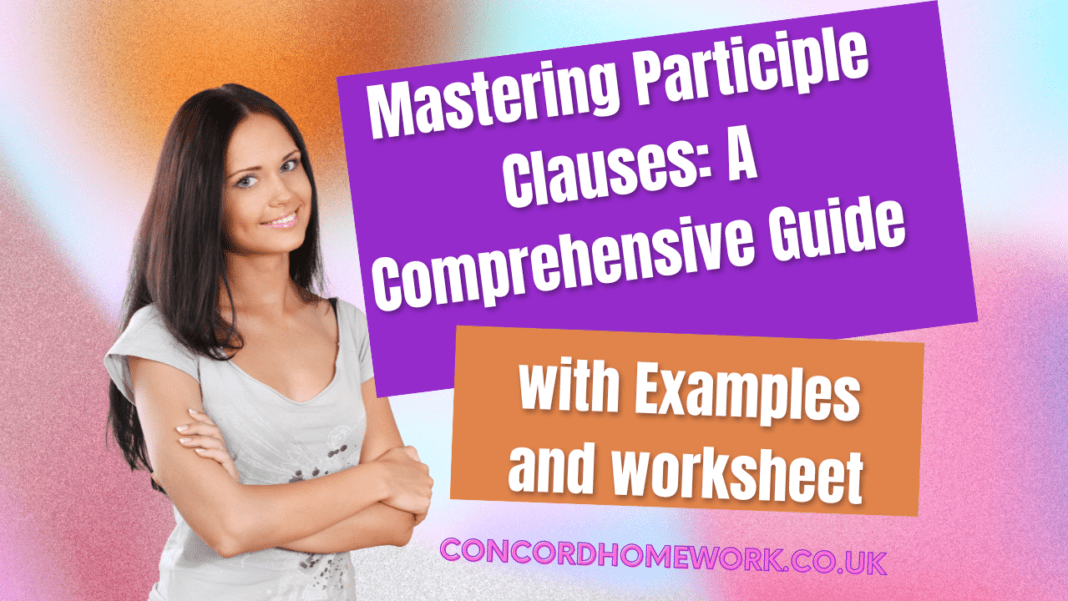Explanation of Participle Clauses
Participle clauses can be a bit confusing at first, but they are very useful in making your writing more concise and formal. In this guide, we will explore three main types of participle clauses: present participle clauses, past participle clauses, and perfect participle clauses.
Understanding Participles
Before we dive into participle clauses, let’s clarify what participles are:
- Present Participle: The -ing form of a verb (e.g., talking, running). Note: It’s not the same as a gerund, although they look alike.
- Example: “I am reading.” (Here, reading is a present participle used in a continuous tense.)
- Past Participle: The third form of a verb (e.g., gone, seen, eaten).
- Example: “She has eaten.” (Here, eaten is a past participle used in perfect tense.)
- Perfect Participle: Combines having with a past participle (e.g., having gone, having eaten).
- Example: “Having finished his homework, he went out to play.”
Types of Participle Clauses
- Present Participle Clauses:
- Form: Verb + -ing
- Uses:
- To show the result of an action.
- To indicate two actions happening at the same time.
- To give the reason for an action.
- As a shortened form of a defining relative clause.
- Examples:
- Result: “Liam tripped, dropping his books everywhere.”
- Same Time: “Whistling a tune, Maria walked down the street.”
- Reason: “Knowing he was late, Jack ran all the way.”
- Defining Relative Clause: “Look at the dog chasing its tail.” (Equivalent to: “Look at the dog that is chasing its tail.”)
- Past Participle Clauses:
- Form: Third form of the verb (e.g., gone, seen)
- Uses:
- To give the reason for something.
- To add additional information about the subject.
- Examples:
- Reason: “Thrilled by the news, Emma called her friends immediately.”
- Additional Information: “Built in 1950, the old bridge still stands strong.”
- Perfect Participle Clauses:
- Form: Having + past participle
- Uses:
- To show that an action occurred before the main clause.
- To emphasize that the perfect participle clause is the reason for the main clause.
- Examples:
- Sequential Action: “Having studied hard, Sarah passed the exam with flying colors.”
- Reason: “Having been warned about the storm, the fishermen decided to stay ashore.”
Why Use Participle Clauses?
Participle clauses are useful for:
- Making sentences more concise.
- Adding formality to your writing, which is particularly useful in academic and professional contexts.
Detailed Examples
Let’s look at each type with detailed examples:
- Present Participle Clauses:
- Result: “Lucas slipped, spilling his coffee all over his shirt.”
- Same Time: “Typing on her laptop, Rachel listened to music.”
- Reason: “Realizing the door was locked, he searched for his keys.”
- Defining Relative Clause: “The man reading the newspaper is my uncle.” (Equivalent to: “The man who is reading the newspaper is my uncle.”)
- Past Participle Clauses:
- Reason: “Shocked by the sudden noise, Mia jumped out of her seat.”
- Additional Information: “Designed by a famous architect, the museum attracts many visitors.”
- Perfect Participle Clauses:
- Sequential Action: “Having saved enough money, David bought a new car.”
- Reason: “Having been misunderstood, she felt upset.”
Table of Participle Clauses
| Type of Clause | Form | Uses | Examples |
|---|---|---|---|
| Present Participle | Verb + -ing | Show result of an action | Lucas slipped, spilling his coffee all over his shirt. |
| Indicate two actions at the same time | Typing on her laptop, Rachel listened to music. | ||
| Give the reason for an action | Realizing the door was locked, he searched for his keys. | ||
| Shortened form of a defining relative clause | Look at the dog chasing its tail. | ||
| Past Participle | Third form of the verb | Give the reason for something | Shocked by the sudden noise, Mia jumped out of her seat. |
| Add additional information | Designed by a famous architect, the museum attracts many visitors. | ||
| Perfect Participle | Having + past participle | Show action occurred before main clause | Having saved enough money, David bought a new car. |
| Emphasize reason for main clause | Having been misunderstood, she felt upset. |
“Thank you for taking the time to explore this topic with us! We hope you found the information helpful and insightful. Have any thoughts, questions, or additional examples to share? We’d love to hear from you in the comments below!
Don’t forget to spread the word by sharing this blog with your friends, family, and colleagues. Together, let’s continue to learn, grow, and connect with the world around us. Happy reading and sharing!”
Follow Me On TikTok:
Follow me!????????????????
Follow me on YouTube:
-

Watch the video, then answer the question. #learnenglish #quiz #english #shorts
-

Watch the video, then answer the question. #quiz #learnenglish #english #englishquizchannel #shorts
-

Watch and learn #learnenglish #English #shorts
-

Quiz time. Watch then answer the question. #quizchallenge #quiz #riddles #puzzle #shorts
-

Watch the video, then answer the question. #LearnEnglish #QuizTime #english #shorts
-

Quiz time. Watch then answer the question. #quiz #quizchallenge #learnenglish #shorts
-

Watch the video and answer the question. #quiz #learnenglish #english #quizchallenge #shorts
-

Quiz challenge. Watch then answer. #quiz #quizchallenge #learnenglish #shorts
-

Quiz time. Watch then answer the question. #quiz #quizchallenge #shorts
-

Watch the video, then answer the question. #learnenglish #quiz #english
-

Watch the video, then answer the question. #learnenglish #quiz #english #shorts
-

Quiz challenge. Watch then answer. #quiz #quizchallenge #learnenglish #shorts
Subscribe!????????????????
What topics/worksheets do you need? Let me know in the comments below!




















